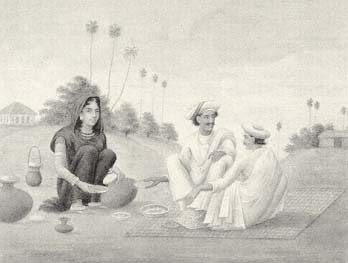
Woman toddy seller serving two customers, by Bani Lal, c. 1880.
Introduction:
Market, Village, and Colonial State in South Asia
The bazaar in the title of this book resonates on two levels: it identifies the site of investigation and it situates the scene of interrogation.[1] Indeed, the very choice of the bazaar as the site of this study is designed to lead to a distinctive scene of interrogation, a stage for posing fundamental questions regarding Indian society under colonialism and for posing questions about narrative history. Certainly the search for a colonial history through the venue of the bazaar highlights a past less familiar than the ones built around those other sites that have come to embody colonial India. The narrative constructed around the bazaar thus draws us to a different reality because the market itself occupies a different place in the Indian landscape.
Markets have long been a familiar and essential feature of the historical landscape, central places of exchange at which peasants, townspeople, landholders, and rulers have historically converged in South Asia to conduct wholesale and retail trade, to gather news and infor-
Read full

No comments:
Post a Comment